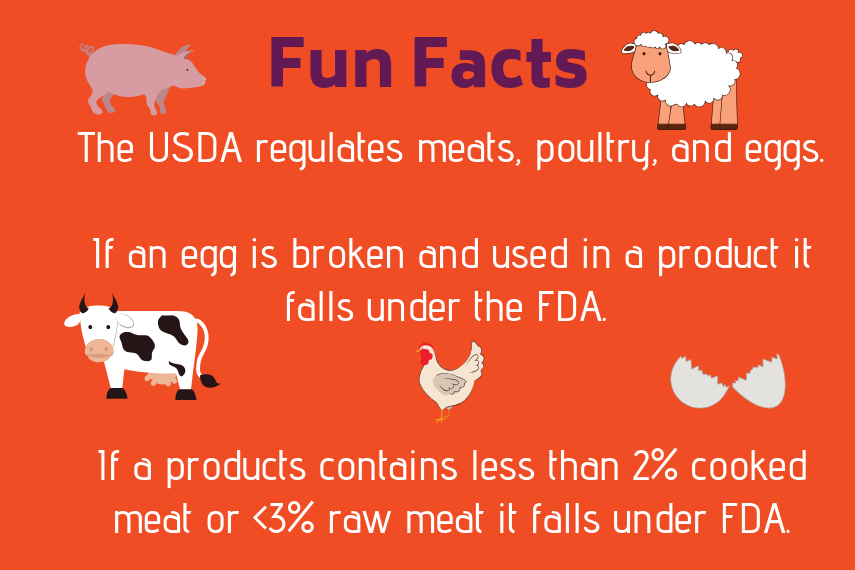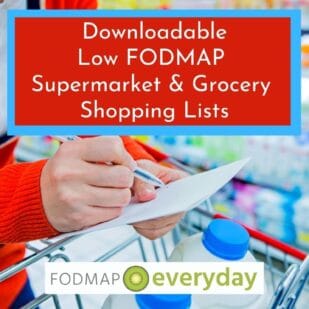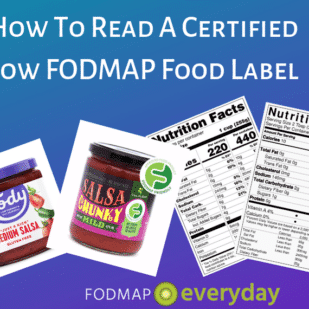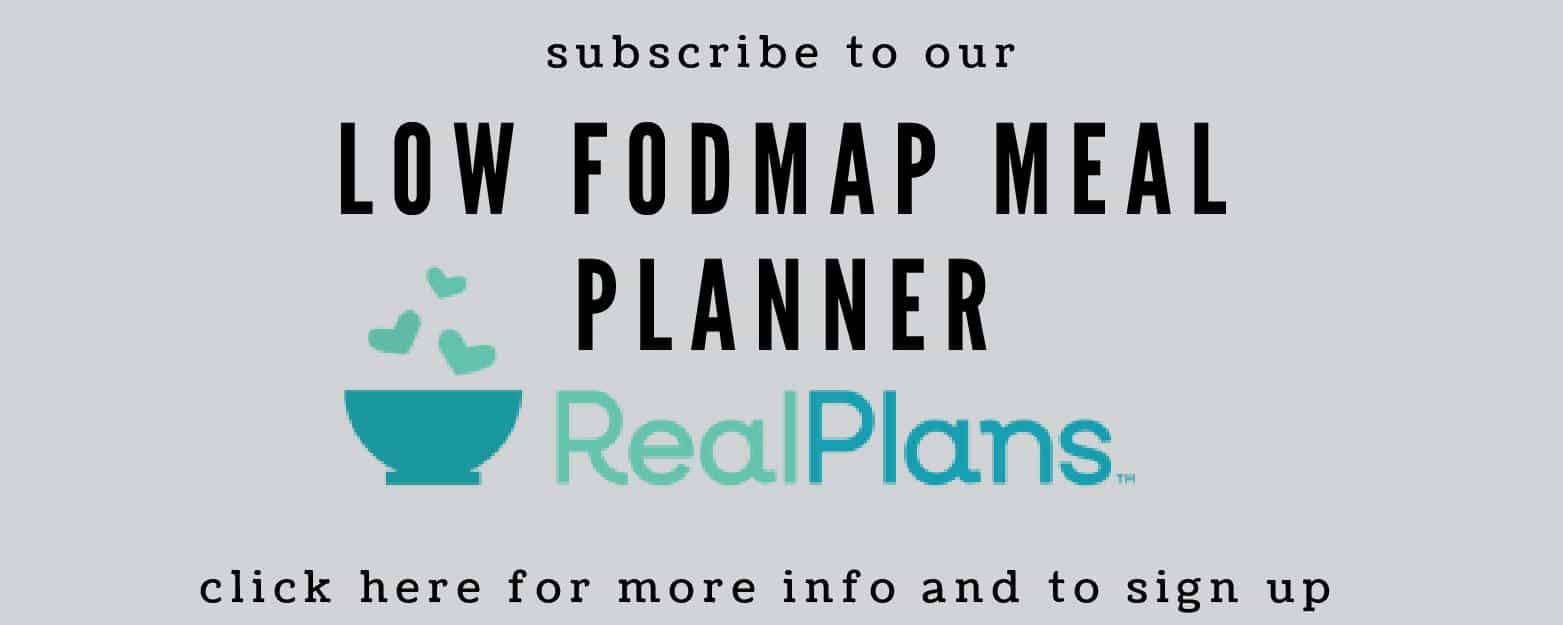Detecting FODMAPs in Prepared Foods
With whole foods like apples, artichokes and milk, it’s easier to identify FODMAPs. It gets trickier when dealing with packaged and multi-ingredient foods. Food labels can be confusing for all consumers, especially those avoiding FODMAPs.

Besides choosing whole foods, here are a few tips to help:
During the Elimination Phase, it’s best to avoid foods that have high FODMAPs ingredients listed on the package. Check the ingredients list for FODMAPs, such as:
-
- Sweeteners such as honey, high fructose corn syrup, agave
- Sugar alcohols including sorbitol, mannitol, xylitol, isomalt, and maltitol. Monash recently stated that erythritol was an exception since it is well absorbed in the small intestines and often produces no side effects.
- Fibers including inulin and chicory root
- Onion, as well as onion salt or powder
- Garlic, as well as garlic salt or powder
- Wheat, barley or rye (if listed as one of the top 3 ingredients[1])
Read From the Top Down
Keep in mind that food labels list ingredients in order of quantity, with the first ingredient having the highest quantity and the last ingredient having the lowest quantity. For example, if tomatoes are the first ingredient listed on a jar of marinara, there are more tomatoes than anything else in that food.
If a high FODMAP ingredient is listed as one of the last ingredients in a food and makes up a very small percentage of that food, you may choose to try that food during the reintroduction phase. Just keep an eye on your symptoms to see if you can tolerate it.
Use Existing Tools to Help
The Monash FODMAPs App and FODMAP Friendly’s Low FODMAP Diet App are essential tools for anyone following the low FODMAPs diet. Use it as a reference for identifying high FODMAP ingredients on a nutrition label.
There are now also an increasing number of low FODMAP certified food products available in the U.S., including FODY Foods and Casa de Sante. While they may not be available yet in your local market, they are available for purchase online. Be sure to check out both the Monash and FODMAP Friendly websites and apps for the latest list.
And more recently there is a product scanning app to help you navigate the supermarket for products that are likely low FODMAP. You can read about The Spoonful App here.
I recently sampled the FODY Dark Chocolate, Nuts & Sea Salt bar at the Digestive Disease Week conference and it was tasty! As a dietitian, I promote whole, fresh foods whenever possible, but I also recognize the convenience of packaged foods, like snack bars.
It’s nice to have options that are nutritious and IBS-friendly!
Be sure to download our Low FODMAP Supermarket Shopping Lists for your favorite markets! You can test your new found knowledge! And read Navigating the Supermarket for Low FODMAP Foods!
Let’s Play Find The FODMAPs
Let’s examine a few ingredients lists more closely. The following food label graphic is from a snack bar. Can you spot the FODMAPs?

A low FODMAP portion of almonds is 10 nuts; unfortunately, it is unclear how many almonds are in this bar from the ingredient list. Furthermore, honey and chicory root fiber are high FODMAPs. Soy lecithin, an emulsifier used in food manufacturing, should not be a source of FODMAPs.
The “natural flavor” in this particular product is unlikely to contain FODMAPs because it is a sweet food. (However, in a savory food, natural flavor may refer to high FODMAP onion or garlic![2]) With almonds listed as the first ingredient and honey and chicory root fiber also listed as ingredients, this food product would be considered high FODMAP.
What Are Natural Flavors?
Natural flavors, natural flavoring, and flavors are common ingredients in an array of food products. The FDA defines natural flavors in CFR – Code of Federal Regulations Title 21 as the essential oil, oleoresin, essence or extractive, protein hydrolysate, distillate, or any product of roasting, heating or enzymolysis, which contains the flavoring constituents derived from a spice, fruit or fruit juice, vegetable or vegetable juice, edible yeast, herb, bark, bud, root, leaf or similar plant material, meat, seafood, poultry, eggs, dairy products, or fermentation products thereof, whose significant function in food is flavoring rather than nutritional.
Should I Avoid Products with Spices?
The FDA defines the term spice means any aromatic vegetable substance in the whole, broken, or ground form, except for those substances which have been traditionally regarded as foods, such as onions, garlic and celery; whose significant function in food is seasoning rather than nutritional; that is true to name; and from which no portion of any volatile oil or other flavoring principle has been removed.
Spices include the spices listed in 182.10 and part 184 of this chapter, such as the following: Allspice, Anise, Basil, Bay leaves, Caraway seed, Cardamon, Celery seed, Chervil, Cinnamon, Cloves, Coriander, Cumin seed, Dill seed, Fennel seed, Fenugreek, Ginger, Horseradish, Mace, Marjoram, Mustard flour, Nutmeg, Oregano, Paprika, Parsley, Pepper, black; Pepper, white; Pepper, red; Rosemary, Saffron, Sage, Savory, Star aniseed, Tarragon, Thyme, Turmeric. Paprika, turmeric, and saffron or other spices which are also colors, shall be declared as “spice and coloring” unless declared by their common or usual name.
What does this mean? Basically foods that are regulated by the FDA must declare garlic and onion on the ingredient list and they CAN NOT be contained within the spices.
So What About Natural Flavors?
Garlic, garlic powder, onion and onion powder CAN be contained within the natural flavors in products that are regulated by the FDA. So what about foods that are regulated by the USDA?
The USDA does not allow garlic or onion to fall under natural flavors, however they allow garlic powder and onion powder since these are not considered foods!
Several of these fun USDA facts were acquired from a lovely conversation I had with a woman from the USDA label department. The bottom line…it may behoove you to call or email a company to inquire about natural flavorings in a savory food product, FDA or USDA.
So What About Non Savory Foods with Natural Flavors?
Many low FODMAP trained RDNs do not consider natural flavors as potential high FODMAP ingredients, while others may recommend natural flavors if they are less than 2% of total ingredients in a food product. As a low FODMAP grocery list curator I have had many conversations and sent many emails to companies about their natural flavors.
The majority of the time garlic and onion are contained in savory options. On a one occasion I was told that chicory root may be used in the natural flavors, but he was unable to confirm. Natural flavors are a big business in the USA and they are proprietary blends that are created specifically for a company to make their food products have a unique flavor profile.
If a high FODMAP fruit was used in the process there is unlikely enough of the fruit to trigger a FODMAP response, especially now with the recent Monash fruit updates. It is best to discuss this topic with your dietitian or healthcare professional if you have concerns.
Read More in our article that dives deep into natural flavors from a FODMAP perspective.
Let’s Look at What We Can Eat!
Now, below is an example of a snack bar with ingredients that many FODMAPers have tolerated well:
Image Source: GoMacro
This bar contains many recognizable low FODMAP ingredients. Peanut butter chips are not listed on the Monash app, but most of their ingredients are. Cocoa butter is also not listed on the app, but it is contained within dark chocolate, which has been given a pass by Monash. By careful label reading and extrapolation we can make an educated assessment that this would be low FODMAP and a good snack bar to try.
As always, go slowly and try foods that are new to you in small amounts and see how you tolerate them. You can become your own best advocate – and shopper – with some attention to detail.
Resources
[1] Tuck, Caroline. “Label reading – how to spot the FODMAPs”.
[2] USDA Food Labeling re: “natural flavors”.










